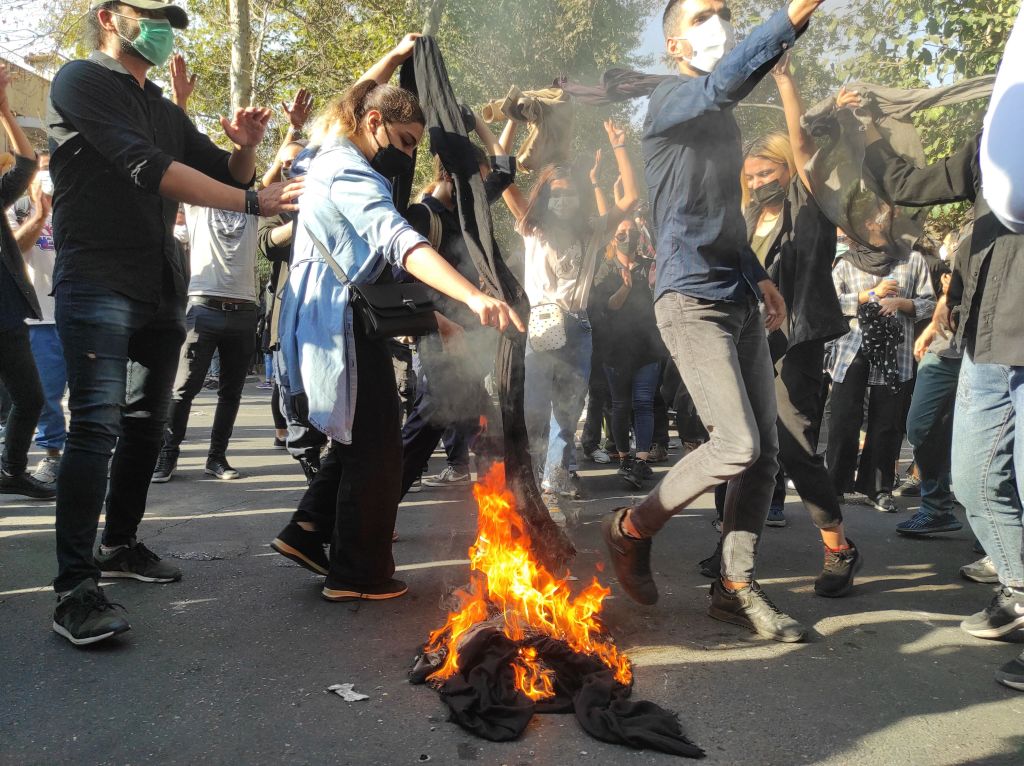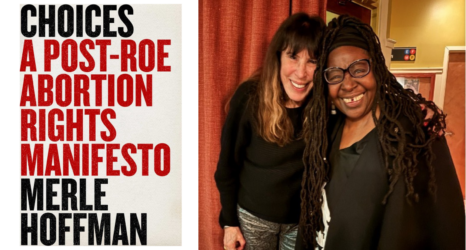Update Dec. 14, 2022: United Nations member states have voted to remove Iran from the Commission on the Status of Women, a significant arm of the U.N. overseen by the Economic and Social Council of the United Nations. The dramatic move shows the power of the ongoing protests and rebellion among Iranian women and their allies.
Over the last week, Iran has increased its brutal crackdown against demonstrators, and officials have begun public executions—”a last-ditch effort by the government to suppress an uprising that has become the most profound and widespread since the 1979 revolution that brought the clerics to power,” according to the New York Times.

Iranian women, tired of being told what to do with their bodies, are burning their headscarves. Men cheer them on, blocking fists and batons crashing down on their sisters.
“Please, let me know you’re okay.”
My message to my brother, unread, sits in the chat box. He is in Tehran. I am in Baltimore. The separation is unbearable. Right now, I don’t even want an answer. I want a sign that means he’s alive, that he’s not dead, that the internet has been restored, that he hasn’t been arrested or beaten.
As my stomach churns with every thought, I aimlessly scroll through Instagram. It really is happening! Iran is imploding. The death of the 22-year-old Iranian woman, Mahsa Amini, at the hands of the “morality police” hasn’t just sparked spontaneous protests—it’s countrywide. Women are removing their headscarves and burning them because they are tired of being told what to do with their bodies. Men cheer them on, and some block the fists and batons crashing down on their sisters.
Suddenly, my phone rings. My brother is calling from his landline.
“I can’t talk long.” He doesn’t say why but I know it’s because of the long-distance call. Usually, when he calls from WhatsApp, I ask what he’s been eating lately. I worry if he’s getting enough food with the food prices increasing daily. This time, I stay quiet and let him talk.
“There is no internet,” he continued. “I’m calling because I know you’d worry.”
I beg him to stay inside. I’m not proud of it, but he is my only family. He doesn’t care much about appearances, and his unkept hair and modest clothing could get him mistaken for a Basiji—the paramilitary volunteer militia always on the forefront of crushing opposition. They are merciless when it comes to defending their values and religion.
But in recent days, the tables have turned. These state-sanctioned militia members—sometimes appearing beleaguered and outnumbered—have received fierce retaliation from waves of protesters. I’ve seen the videos. Some people are so angry they fight the militia. “Bokoshesh,” a voice screams from behind a cell phone. In the distance, a man who has lost his weapon is on the ground. A crowd of young men and women are kicking him. “Kill him,” the voice repeats.
I don’t want my brother arrested. Having grown up in Iran, I know what its government does. After months of physical and mental torture, they force the prisoners to appear on TV. Emaciated, exhausted and devoid of light, they confess and apologize for conspiring to topple the regime. I have read the memoirs of journalists like Maziar Bahari and Jason Rezaian, whose chronicles of time in Iranian prison are unimaginable horror.
I’m a pessimist. I lost hope for Iran in July 1999 when the students’ protest disaster was my first experience of a crushed uprising. The descriptions of young men pushed out windows when college dorms were raided at night stayed with me for years.
After coming to America in 2003, I followed the news of one unrest after another. The largest occurred in 2009 after the fraudulent presidential elections, known in the West as the Green Movement. A sea of people peacefully marching and demanding their votes to be counted was shot at and eventually sent home.
And again, in 2019 when in 12 months, hundreds—thousands by unofficial records—were killed for protesting the rising price of gas, food and corruption that made a few government officials and their allies millionaires, while many had to dive waist-deep into dumpsters in search of food.
My brother said people go about their lives and businesses during the day, but all night long, he hears the sounds of shootings and slogans. Given his location, I tell him to keep his door open if protesters need a place to hide from the police. Before we hang up, he said, “Don’t watch the news and get upset.” I have not heard from him since Thursday, Sept. 20.
For the next few days, by the end of the first week of protests, I hear from every friend and relative I have messaged:
Thursday, Sept. 22
“Internet is spotty. OK, but the deaths are unbearable, like floating in my own blood.”
She is a poet.
Friday, Sept. 23
“I’m OK, but I can’t fathom how men can be turned into such killing machines? They must be drugged.”
She is a pharmacist.
Saturday, Sept. 24
“Just got connected. I’m really shaken. Yesterday, I saw a man bludgeoned in front of my eyes. The police chased me, but I ran for my life.”
She is my baby cousin.
Sunday, Sept. 25
My cousin messages again:
“Our car was attacked by a mob of Basijis with batons. They said I wasn’t wearing a headscarf. I stuck my head out the window and screamed, are you blind?! They let us go.”
“Sorry for the late reply. The Internet is down. We don’t go out, but our hearts are shattered that these kids are dying every day.”
She is a mother.
“Internet speed is very slow. We drove and honked. Daughter’s school is closed.”
She is a hairdresser.
Monday, Sept. 26
“I’m OK because I’m staying home. Scared for Sara.”
She is a mother of a small girl.
“I’m OK. Nothing is happening where I am. People were beaten so severely that no one is returning to the streets.”
He is a college student.
Women in Tehran marching without the compulsory hejab. One of the ideological pillars of the Islamic Republic is beginning to crumble. pic.twitter.com/RbptHfn9KT
— Karim Sadjadpour (@ksadjadpour) October 1, 2022
What is taking shape in Iran is not an opposition against religion. This is also not the prevalent Western narrative of oppressed Muslim women rising. The issue of the hijab is complex. One can be very religious but not believe in wearing the headscarf. One could not be religious but do for modesty or a fashion statement.
This is a protest against 40 years of crackdowns on bodies, freedom of speech, freedom of expression, freedom to choose a religion and freedom of sexual orientation, and imprisoning or killings writers, journalists and artists.
What is exceptionally different this time is that young men, who themselves have suffered other forms of oppression at the hands of the regime, have recognized women’s bravery and role in leading the movement. For the first time in modern Iranian history, the men have realized the importance of women’s rights and are putting their lives in line to keep the fires women have ignited alive.
Video of school girls walking down a street in Tehran without a hijab chanting “Death to the Dictator.” There are scenes of these acts of protest among school children throughout #Iran. #MahsaAmini pic.twitter.com/CKAr00i3td
— Jason Brodsky (@JasonMBrodsky) October 4, 2022
Since the death of Mahsa Amini and the subsequent events, anyone concerned with Iran asks whether this uprising is any different from the ones before it. Friends on the streets tell me that the youth are not backing down. Some have the support of the older generations who, from the safety of their homes, shout anti-government slogans and/or join the strikes by closing their businesses. Some don’t get any support. The death tolls are rising. Many get beaten, shot by plastic bullets, or arrested. Yet the protests continue.
I’m stunned by what surfaces on social media:
- a video of a bereaved sister cutting her long hair over the dead body of her brother shot to death when protesting;
- a daughter with shaved head holding a lock of hair over the grave of her mother;
- a photograph of two child soldiers in military uniform bearing batons and shields, which later is digitally edited by an Iranian artist to remind us they are just children—they hold, books, toys and musical instruments.
As I wait to hear from my brother and friends again, I wonder about the future of my homeland. I pray. I lose hope, I gain hope and I get inspired to write and translate anything that could help my people’s struggle for freedom. Above all, I know this is the movement that will decide Iran’s future and cannot be silenced.
Editor’s note: Names, including the cities, have been changed to protect the identities of individuals in Iran.
U.S. democracy is at a dangerous inflection point—from the demise of abortion rights, to a lack of pay equity and parental leave, to skyrocketing maternal mortality, and attacks on trans health. Left unchecked, these crises will lead to wider gaps in political participation and representation. For 50 years, Ms. has been forging feminist journalism—reporting, rebelling and truth-telling from the front-lines, championing the Equal Rights Amendment, and centering the stories of those most impacted. With all that’s at stake for equality, we are redoubling our commitment for the next 50 years. In turn, we need your help, Support Ms. today with a donation—any amount that is meaningful to you. For as little as $5 each month, you’ll receive the print magazine along with our e-newsletters, action alerts, and invitations to Ms. Studios events and podcasts. We are grateful for your loyalty and ferocity.
Up next:





